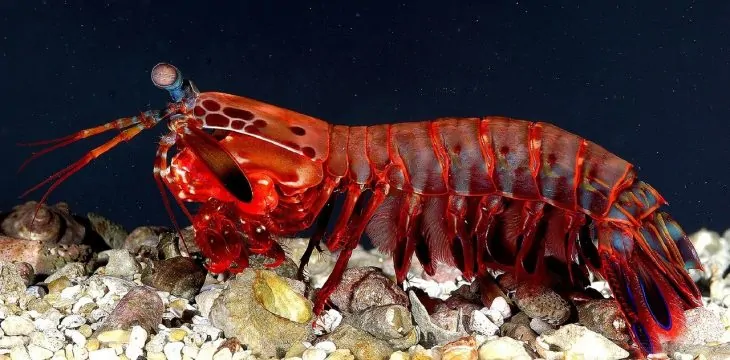
Packing a serious punch, mantis shrimps or stomatopods are the definition of “small but terrible”. Sounds impossible for one to create underwater shock waves with your fists, but mantis shrimps know it all too well. These crustaceans are notorious for dealing the most powerful strike in the animal kingdom—all while sporting a colorful and elegant exterior. Explore what we know about these mesmerizing creatures with these mantis shrimp facts.
- Mantis shrimps evolved separately from the class Malacostraca around 340 million years ago.
- There are around 451 known species of mantis shrimp.
- Mantis shrimps generally grow to around 4 inches (10 cm) in length.
- They may breed up to 20 to 30 times in their lifetime.
- The largest mantis shrimp ever caught had reached a size of 18 inches (46 cm).
- Mantis shrimps are solitary crustaceans that prefer to hunt alone.
- They are predators that spend most of their time in underwater rocks and burrows.
- Mantis shrimps prefer to live in shallow waters in tropical and subtropical regions.
- They evolved before dinosaurs existed.
- Stomatopods are aggressive and territorial.
- Mantis shrimps are marine crustaceans that belong to the order Stomatopoda. Scientists refer to them as stomatopods.
- They can either be active in the day, night, or at twilight depending on the species.
- Most mantis shrimps live in the Pacific and Indian Oceans.
- Some species live in temperate regions.
- Mantis shrimps have compound eyes that consist of tens of thousands of individual units.
- Mantis shrimps can take on prey much larger than themselves.
- They get their names from their mantis-like front claws.
- Mantis shrimps’ eyes sit on movable stalks and can move independently of one another.
- Their sensitivity to pollutants make them good bioindicators for the health of coral reefs.
- Mantis shrimps are important predators that keep populations of various sea animals in check.
Mantis Shrimp Facts Infographics
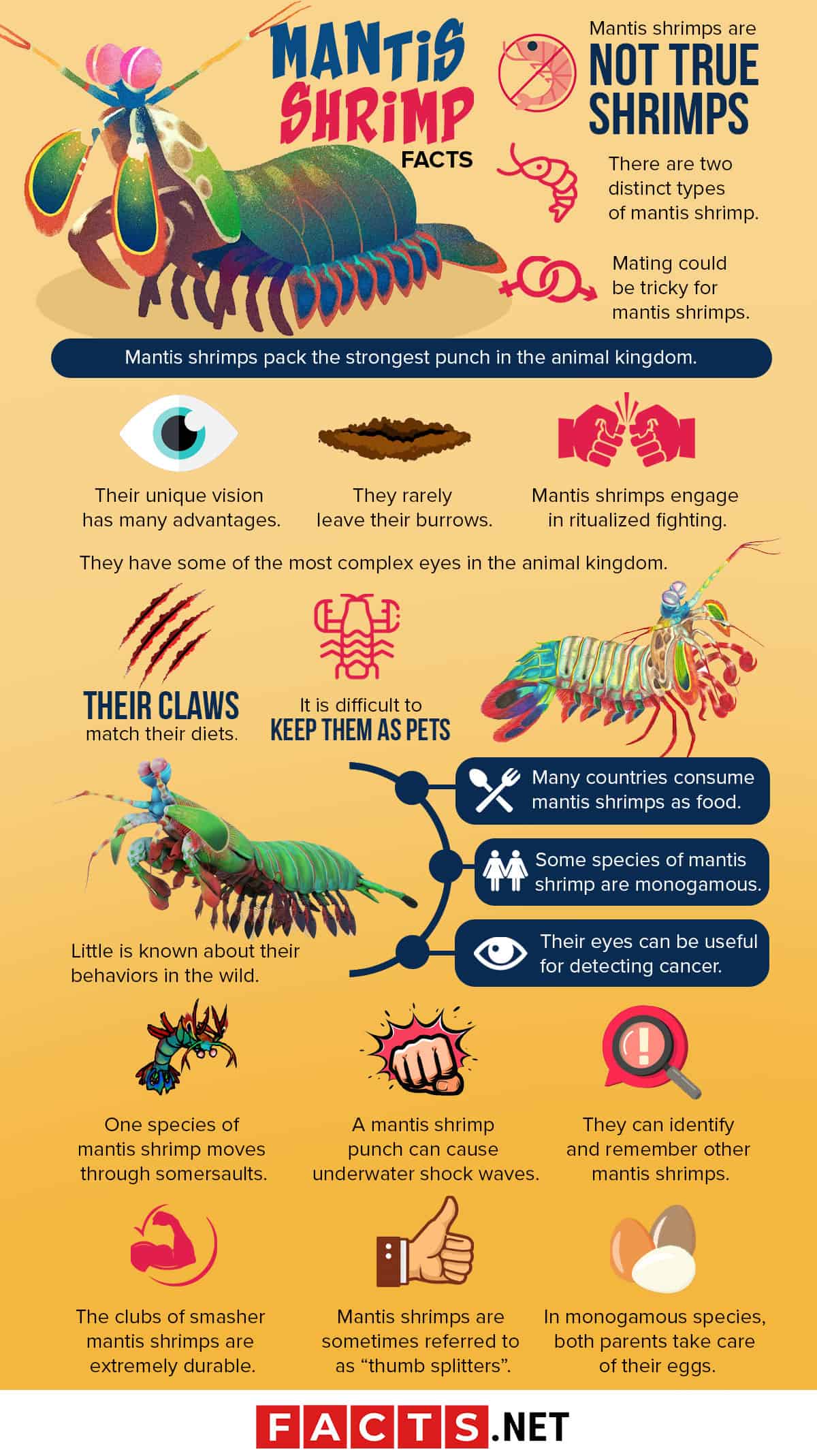
There are two distinct types of mantis shrimp.
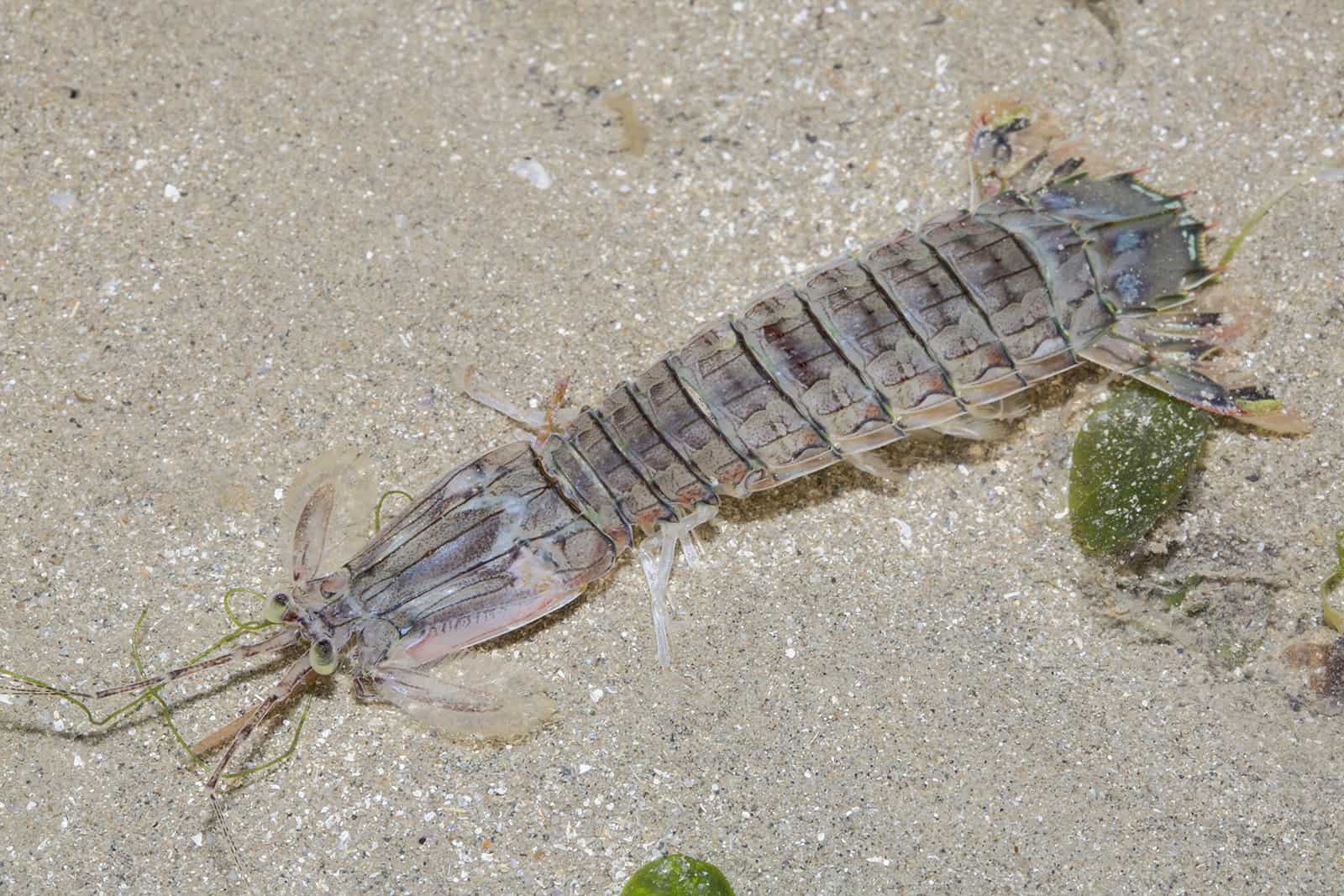
Although hundreds of species exist, there are two general types of mantis shrimp. Depending on their specialized claws and their methods of killing prey, stomatopods can either be “smashers” or “spearers”.
Smasher stomatopods have unique club-like claws that they use to bludgeon or “punch” their prey. They use their claws like hammers and break the shells of their prey with immense blunt force.
Spearers, on the other hand, have spear-like claws which inspire their names. Their claws are sharp and barbed, and they use them to stab, slice, and snag their prey.
Mantis shrimps are not true shrimps.
Contrary to what their name suggests, mantis shrimps are neither mantises nor shrimps. Although they’re crustaceans and therefore distantly related to shrimps, crabs, and lobsters, stomatopods belong to their own distinct order.
Mantis shrimps pack the strongest punch in the animal kingdom.
One of the most interesting and popular mantis shrimp facts is that they have the strongest striking power in the animal kingdom—as well as the fastest punch in the ocean.
Although both types of mantis shrimp reach breakneck striking speeds, smashers have appendages that are more specialized to deal powerful blows. The punches of smashers can reach an acceleration of 10,400 g and a velocity of 51 mph (83 km/h). That’s around 50 times faster than the blink of an eye.
Despite their small size, their quick punches have a force of more than 1,500 newtons, which can be compared to the force of a .22 caliber bullet. They can reach such immense force because they have some form of biological springs in their appendages that allow them to deal lethal blows that otherwise can’t be reached by muscle power alone. These specialized appendages allow smashers to easily break into the hard shells of their prey.
A mantis shrimp punch can cause underwater shock waves.
If you’re a sea creature that’s come face-to-face with a mantis shrimp, you might think it would be easy to avoid the risk of death by simply evading their punches. Unfortunately, it would not be that easy to evade their strikes. The strikes of mantis shrimps can reach speeds enough to create small vapor-filled bubbles. These are known as cavitation bubbles, and when they collapse, they turn into shock waves underwater.
These shockwaves are a result of an abrupt and drastic change in underwater pressure due to the force of the punch. They effectively give the mantis shrimps an extra punch in case they miss their prey. The shock waves are strong enough to stun prey, if not dismember them or kill them in an instant.
The cavitation bubbles brought by the punches of mantis shrimps collapse with such immense force that they also produce heat and a small amount of light. Temperatures inside the bubble can reach up to 20,000 Kelvin — hotter than the surface of the sun. Scientists refer to the momentary burst of light due to the imploding bubbles as “sonoluminescence”.
The clubs of smasher mantis shrimps are extremely durable.
Every action has an equal and opposite reaction; with such astonishing power, you may be wondering how the mantis shrimp does not seem to sustain damages from the strikes that it blows. As it turns out, their clubs have layers of elastic chitin which act as shock absorbers and protect the appendages from breaking. Scientists are currently studying these structures in the hopes of making more durable car frames, aircraft panels, and body armor.
Mantis shrimps are sometimes referred to as “thumb splitters”.
Humans have many different nicknames for stomatopods. For example, Ancient Assyrians called them “sea locusts”, and Australians call them “prawn killers”. Perhaps their most interesting nickname, however, is “thumb splitters”. They get this nickname from their tendency to injure unwary handlers.
Mating could be tricky for mantis shrimps.
Because these crustaceans are naturally aggressive and territorial, mating could be quite a perilous endeavor, especially for males. In most species, males often have to fight their way in a female’s burrow, and they leave after they fertilize the female’s eggs. Being out in the open can pose quite a risk for the males because they’d be in danger of being eaten by large predators. As a result, older mantis shrimps tend to have a high female-to-male ratio of about five females to one male.
In some species, the females come to the burrows of the males. However, some of the female visitors try to evict the males when they aren’t ready to breed yet. Interestingly, many males will only let the females in on a full moon because this is when they’re most likely to breed and therefore are less likely to evict the males from their homes.
Some species of mantis shrimp are monogamous.
Most stomatopods are solitary, and breeding pairs only come together to mate. However, some species are monogamous and may live together. Some pairs may even spend up to 20 years together.
In monogamous species, both parents take care of their eggs.
Far from their seemingly violent and aggressive nature, mantis shrimps can be quite responsible parents. The monogamous species of mantis shrimp, such as those in the genera Pullosquilla and Nannosquilla, tend to raise their eggs together. In some species, the females lay two clutches of eggs, and each of the parents takes care of one clutch of eggs. With other species, on the other hand, the females take care of the eggs while the male hunts for food for both parents.
They have some of the most complex eyes in the animal kingdom.
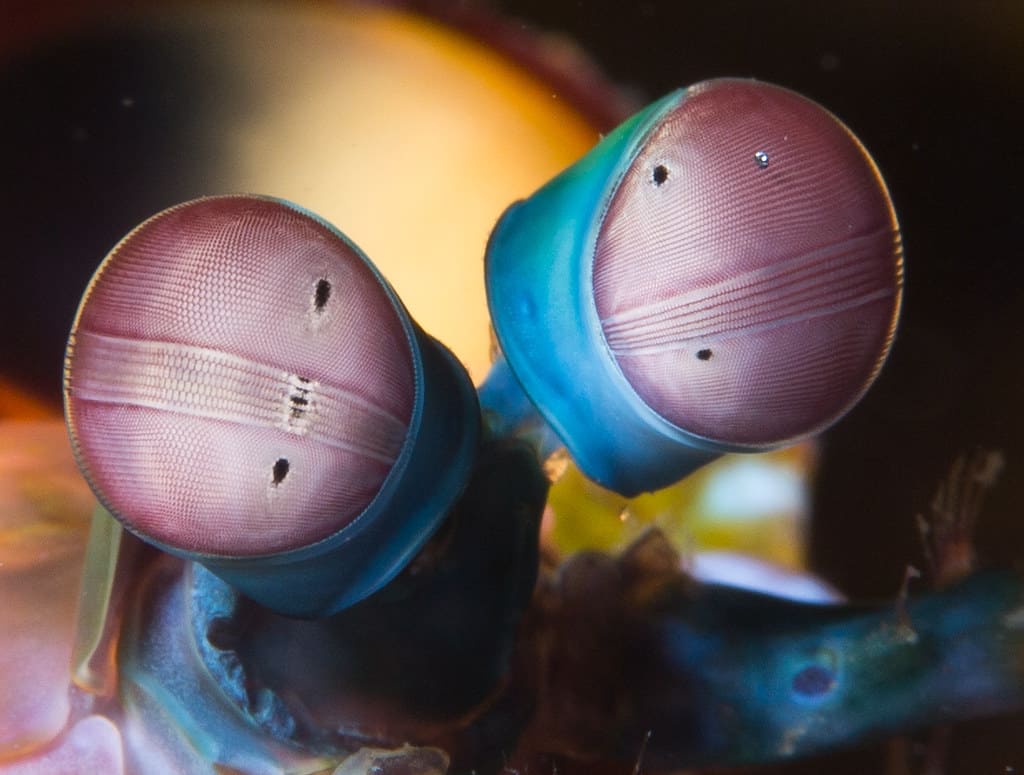
Humans have three types of photoreceptor cells in their eyes. Mantis shrimp eyes, however, have 12 to 16 types of these color-sensitive cones. They also have the ability to fine-tune their color vision in response to their environment. Mantis shrimps can see a wide spectrum of light, from far-red light to deep ultraviolet and polarized light. They can quickly process visual information, which is important for both hunting and avoiding predation.
Their unique vision has many advantages.
Mantis shrimps have the ability to detect light that humans and many other animals can’t. While there’s no clear reason why they have such complex eyes, scientists suggest that their unique vision provides them with a number of evolutionary advantages.
Some scientists postulate that they can use polarized light as a form of secret communication because many predators don’t have the ability to detect polarized light. Stomatopods emit certain wavelengths of light during mating rituals, and others of their species can detect these wavelengths.
Their complex eyes could also help them detect transparent and semi-transparent sea creatures on coral reefs, as well as the shimmering scales of barracuda, one of their potential predators. They also have excellent depth perception, which allows for quick and accurate strikes.
Their eyes can be useful for detecting cancer.
Because the highly-developed eyes mantis shrimps can detect polarized light, scientists are attempting to replicate their complex vision to make cameras that could detect cancer cells. The reason for this is because some polarized light reflects differently between healthy and cancerous tissues.
Mantis shrimps engage in ritualized fighting.
When it comes to disputes regarding food or territories, mantis shrimps prefer to resolve them through ritualized fighting. They spar non-lethally with other individuals of their species, and some scientists refer to this as “telson sparring”.
During the ritualized fighting, the stomatopods take turns in striking the telsons (tail plates) of their opponents. They typically don’t strike anywhere else but their telsons, and their strong armor provides them with ample protection against lethal strikes.
They can identify and remember other mantis shrimps.
Mantis shrimps display some intelligence and social behaviors, and they can recognize other mantis shrimps through visual cues and even their smell.
They rarely leave their burrows.
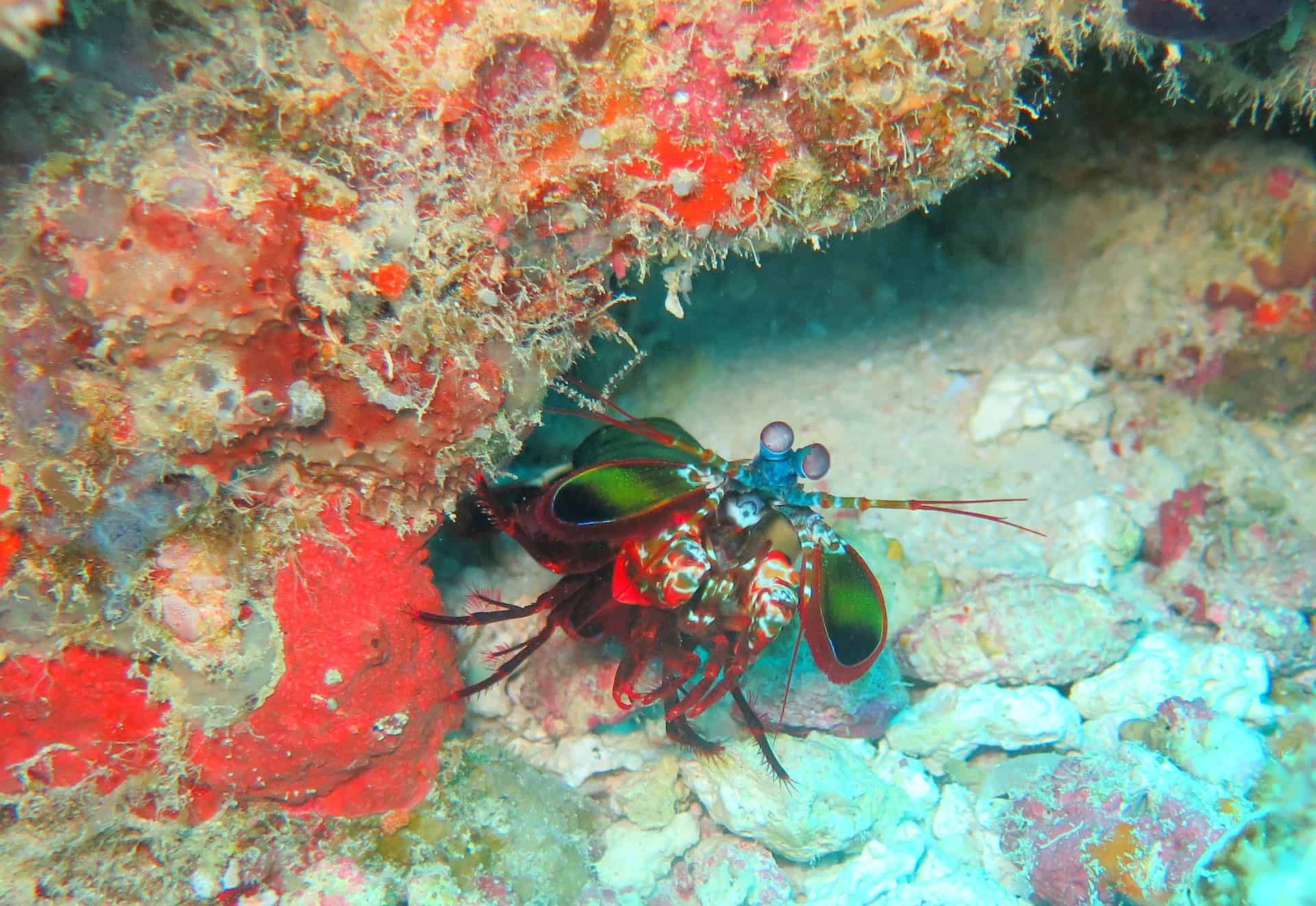
Mantis shrimps live in burrows that are either U-shaped or with complex passageways. They hide and consume their food within these burrows and rarely leave unless they have to hunt or mate.
Smashers and spearers tend to live in different environments. Spearers prefer to live in softer ground such as under the cover of sand. This helps them easily hide and lie in wait until they have to strike. They can also modify their burrows to fit them as they grow bigger. Smashers, on the other hand, prefer to live within hard rocks or corals. As they grow, they may have to relocate and find bigger burrows.
Their claws match their diets.
The claws of mantis shrimps, either smashers or spearers, match what they eat. Smashers use blunt force to smash open the shells of their prey, which mostly consists of snails, other crustaceans, and shellfish. Spearers, on the other hand, mostly opt for fish and other soft-bodied sea creatures.
Many countries consume mantis shrimps as food.
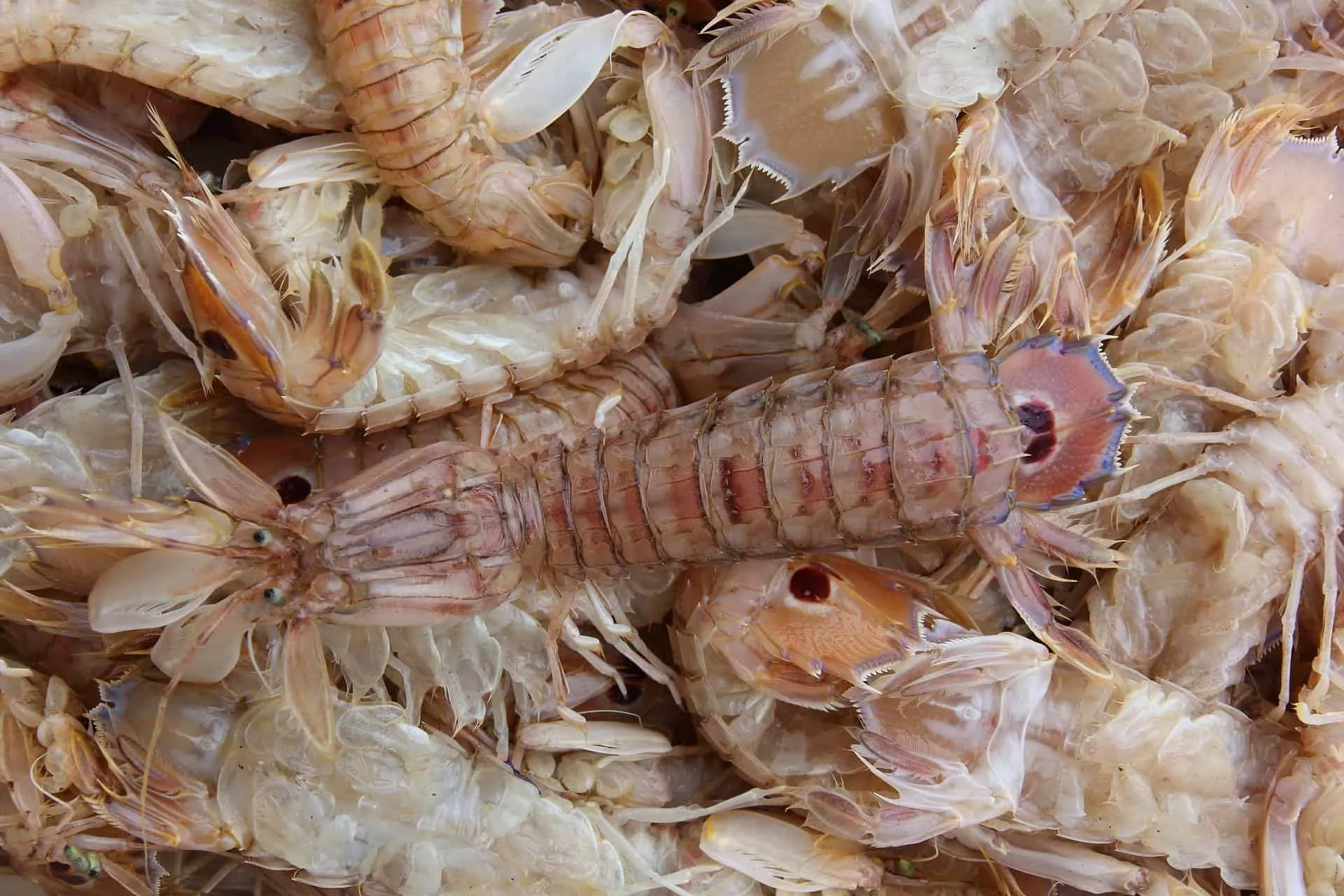
The mantis shrimp is popular as food and is present in many cuisines all over the world. It’s common to find them in Mediterranean and Asian cuisines, and there are various methods of preparation. They can be boiled, dried, fried, or grilled. Their meat is closer to the meat of lobsters than that of shrimps.
It is difficult to keep them as pets.
With their often striking coloration and interesting habits, you might be wondering if people have successfully kept a pet mantis shrimp. Some do keep them in captivity, and the peacock mantis shrimp is a popular choice because of its unique show of colors.
Other saltwater aquarists, however, deliberately avoid stomatopods. They damage live rocks and corals, are voracious eaters, and difficult to catch. Their powerful punches are also strong enough to break glass, which is not the most ideal situation for any aquarium-keeper.
Little is known about their behaviors in the wild.
Most species of mantis shrimps are quite common and generally not close to the threat of extinction. However, it’s difficult to monitor their behaviors in the wild because they live most of their lives in the comfort of their burrows.
One species of mantis shrimp moves through somersaults.
Although mantis shrimps generally move similar to the movements of shrimps and lobsters, one species is interesting because it can move through somersaults. This stomatopod species is Nannosquilla decemspinosa, and it can wheel itself over level ground and even in ascending slopes. It can move this way because of its flexible body and relatively weak legs. This type of movement is useful in moving them across sand during low tides.
Was this page helpful?
Our commitment to delivering trustworthy and engaging content is at the heart of what we do. Each fact on our site is contributed by real users like you, bringing a wealth of diverse insights and information. To ensure the highest standards of accuracy and reliability, our dedicated editors meticulously review each submission. This process guarantees that the facts we share are not only fascinating but also credible. Trust in our commitment to quality and authenticity as you explore and learn with us.
